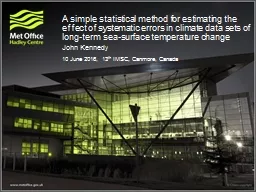

effect of systematic errors in climate data sets of longterm seasurface temperature change John Kennedy 10 June 2016 13 th IMSC Canmore Canada The Problem Part I lots of little problems ID: 785268
Download The PPT/PDF document "A simple statistical method for estimati..." is the property of its rightful owner. Permission is granted to download and print the materials on this web site for personal, non-commercial use only, and to display it on your personal computer provided you do not modify the materials and that you retain all copyright notices contained in the materials. By downloading content from our website, you accept the terms of this agreement.
Slide1
A simple statistical method for estimating theeffect of systematic errors in climate data sets of long-term sea-surface temperature change
John Kennedy
10 June 2016, 13
th
IMSC,
Canmore
, Canada
Slide2The Problem – Part Ilots of little problems2004
Slide3Further Exploring and Quantifying Uncertainties for Extended Reconstructed Sea Surface Temperature (ERSST) Version 4 (v4)B. Huang, P.W. Thorne, T.M. Smith, W. Liu, J. Lawrimore, V.F. Banzon, H-M. Zhang, T.C. Peterson, and M. Menne Journal of Climate 2016 29:9, 3119-3142 The Problem – Part IIBIG problems
Slide4Possible
artifacts of data biases in the recent global surface warming hiatus, T.R. Karl, A. Arguez,
B.
Huang,
J.H
.
Lawrimore
,
J.R
. McMahon,
M.J
.
Menne
,
T.C
. Peterson,
R.S
.
Vose
,
H. Zhang,
Science
26
Jun 2015 : 1469-1472
Slide5The solution?I will be using coarsely gridded SST data5 degree latitude by 5 degree longitude monthlyModel the global SST field as a multivariate Gaussian random fieldSST ~ N(0, C)
Slide6The solution?
Spatial Covariance
Error Covariance
Subsampler
DATA
Solution
Slide7The solution!
DATA
Solution
Estimate of error
The really nice thing about R is that you can break it down into separate components: individual ships, all German ships, all ships using a particular measurement system
Slide8Karspeck, A. R., Kaplan, A. and Sain, S. R. (2012), Bayesian modelling and ensemble reconstruction of mid-scale spatial variability in North Atlantic sea-surface temperatures for 1850–2008. Q.J.R. Meteorol. Soc., 138: 234–248. doi: 10.1002/qj.900
Spatial covariance a simple function of the zonal and meridional separation between points Construct spatially-varying length scale and variance Using method of Karspeck et al. 2012
Spatial
Covariance
Slide9Error covariance (R)Observation=
SSTUncorrelated error
+
Errors which affect each measurement differently
Slide10Error covariance (R)Observation=
SSTUncorrelated error
Micro bias
+
+
Errors which affect each ship differently
Slide11Error covariance (R)Observation=
SSTUncorrelated error
Micro bias
Macro bias
+
+
+
Errors which affect the whole global fleet of ships
Slide12Two step assimilation of dataGrid data at 5 degree, monthly resolutionMake prior covarianceAssimilate high-quality (e.g. buoy) data
Update mean and covarianceAssimilate ship dataEstimate macro and micro bias terms
Slide13Compare ship data to reliable satellite estimates
Estimated micro bias
SST retrievals from the Along Track Scanning Radiometer instruments as processed in the ARC project (ATSR Reanalysis for Climate)
Merchant, C. J., et al. (2012), A 20 year independent record of sea surface temperature for climate from Along-Track Scanning Radiometers, J.
Geophys
. Res., 117, C12013, doi:
10.1029/2012JC008400
.
Slide14Slide15In situ SST Quality Monitor (iQuam)Feng Xu and Alexander Ignatov. Journal of Atmospheric and Oceanic Technology 2014 31:1, 164-180 Compare to other estimates of ship biases
IQUAM uses a combined satellite and in situ background field to estimate ship biases
Slide16Slide17Recent reduction in macro biasesEstimated bias (degC)
Slide18Pushing further back in time
Atkinson, C. P., N. A. Rayner, J. J. Kennedy, and S. A. Good (2014), An integrated database of ocean temperature and salinity observations, J. Geophys. Res. Oceans, 119, 7139–7163, doi:10.1002/2014JC010053
.
Slide19Summary…A simple error model and……a simple interpolation schemeUsed to estimate biases in SST dataBiases have likely led to a slight underestimate of recent global SST trends, tentatively consistent with the Karl et al. result
…and a plea for help
If you have more powerful methods for solving these kinds of problems it would be great to hear from you
j
ohn.kennedy@metoffice.gov.uk